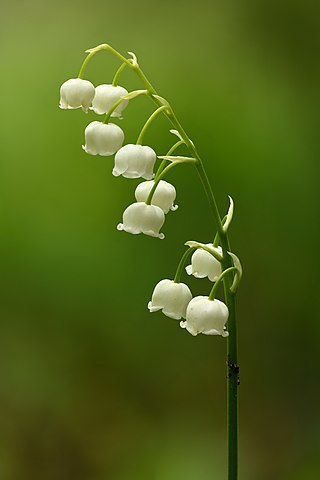
Lily of the valley, sometimes written lily-of-the-valley, is a woodland flowering plant with sweetly scented, pendent, bell-shaped white flowers borne in sprays in spring. It is native throughout the cool temperate Northern Hemisphere in Asia and Europe. Convallaria majalis var. montana, also known as the American lily of the valley, is native to North America.

A daylily or day lily is a flowering plant in the genus Hemerocallis, a member of the family Asphodelaceae, subfamily Hemerocallidoideae, native to Asia. Despite the common name, it is not in fact a lily. Gardening enthusiasts and horticulturists have long bred daylily species for their attractive flowers. Thousands of cultivars have been registered by local and international Hemerocallis societies. Daylilies are perennial plants, whose name alludes to its flowers, which typically last about a day.

Alstroemeria, commonly called the Peruvian lily or lily of the Incas, is a genus of flowering plants in the family Alstroemeriaceae. They are all native to South America, although some have become naturalized in the United States, Mexico, Australia, New Zealand, Madeira and the Canary Islands. Almost all of the species are restricted to one of two distinct centers of diversity; one in central Chile, the other in eastern Brazil. Species of Alstroemeria from Chile are winter-growing plants, while those of Brazil are summer growing. All are long-lived perennials except A. graminea, a diminutive annual from the Atacama Desert of Chile.

Fritillaria meleagris is a Eurasian species of flowering plant in the lily family Liliaceae. Its common names include snake's head fritillary, snake's head, chess flower, frog-cup, guinea-hen flower, guinea flower, leper lily, Lazarus bell, chequered lily, chequered daffodil, drooping tulip or, in the British Isles, simply fritillary. The plant is a bulbous perennial native to the flood river plains of Europe where it grows in abundance.

Lilium mackliniae, the Shirui lily or Shirui Kashong Timrawon, is a rare Indian species of plant found only in the upper reaches of the Shirui hill ranges in the Ukhrul district of Manipur, India, at an elevation of 1,730–2,590 metres (5,680–8,500 ft) above sea level. It is located near the boundary of Myanmar to the east, Shirui village in the west, Choithar village in the south and Sihai village in the north.

Alstroemeriaceae is a family of flowering plants, with 254 known species in four genera, almost entirely native to the Americas, from Central America to southern South America. One species of Luzuriaga occurs in New Zealand, and the genus Drymophila is endemic to south-eastern Australia.

Zantedeschia is a genus of eight species of herbaceous, perennial, flowering plants in the aroid family, Araceae, native to southern Africa. The genus has been introduced, in some form, on every continent.

Zantedeschia aethiopica, commonly known as calla lily and arum lily, is a species of flowering plant in the family Araceae, native to southern Africa in Lesotho, South Africa, and Eswatini.

Hedychium gardnerianum, the Kahili ginger, Kahila garland-lily or ginger lily, is a species of flowering plant in the ginger family Zingiberaceae, native to the Himalayas in India, Nepal, and Bhutan. It is an erect herbaceous perennial growing to 8 ft (2.4 m) tall with long, bright green leaves clasping the tall stems. The very fragrant pale yellow and red flowers are held in dense spikes above the foliage. They appear towards the end of summer.

Anthericum liliago, the St Bernard's lily, is a species of flowering plant in the family Asparagaceae. It is native to mainland Europe and Turkey, growing in dry pastures, stony places and open woods and flowering in early summer. In Sweden, the northernmost stable populations grows along the rocky shores of Lake Sommen, albeit on occasions it has been found as far north as Uppland.
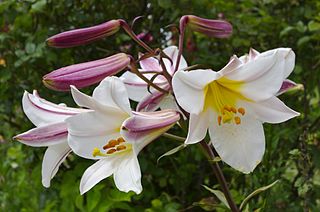
Lilium regale, called the regal lily, royal lily, king's lily, or, in New Zealand, the Christmas lily, is a species of flowering plant in the lily family Liliaceae, with trumpet-shaped flowers. It is native to the western part of Sichuan Province in southwestern China, and cultivated elsewhere as an ornamental. It was introduced to England in 1903 by Ernest Henry Wilson.
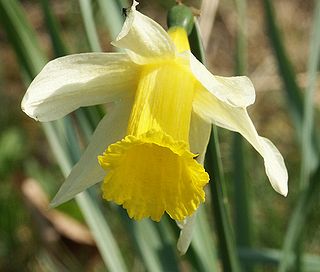
Narcissus pseudonarcissus, commonly named the wild daffodil or Lent lily, is a perennial flowering plant.
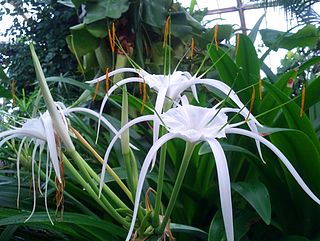
Hymenocallis (US) or (UK) is a genus of flowering plants in the amaryllis family native to the Americas.
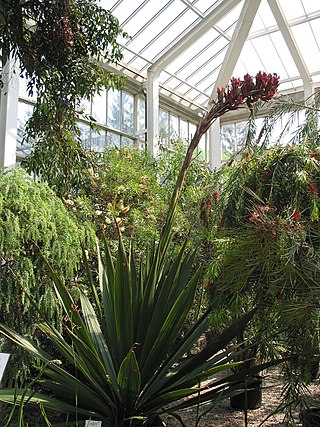
Doryanthes palmeri, also known as the giant spear lily, is one of only two species of plant in the genus Doryanthes and the family Doryanthaceae, both being endemic to eastern Australia. It grows in a rosette and the leaves can reach the length of about 3 m (10 ft). The flowers arise in springtime on a stalk which may reach 5 m (16 ft) in height. A succulent perennial, its leaves are hairless and grow in the shape of a sword. The giant spear lily is listed as Vulnerable under the New South Wales Threatened Species Act (1995).

Sedum rubrotinctum or Sedum × rubrotinctum, commonly known as jelly-beans, jelly bean plant, or pork and beans, is a species of Sedum from the plant family Crassulaceae. It is a succulent plant originating in Mexico. The common English name refers to its short leaves that resemble jelly beans, especially when taking on a protective hue.

Luzula multiflora, the common woodrush or heath wood-rush, is a species of flowering plant in the rush family.

Phormium is a genus of two plant species in the family Asphodelaceae. One species is endemic to New Zealand and the other is native to New Zealand and Norfolk Island. The two species are widely known in New Zealand as flax or their Māori names wharariki and harakeke respectively, and elsewhere as New Zealand flax or flax lily, but they are not closely related to the Northern Hemisphere's flax, which is native to the region extending from the eastern Mediterranean to India and has been used by humans since 30,000 B.C.

Pavonia multiflora, the Brazilian candles or many flowers, is a species of flowering plant in the Hibisceae tribe of the mallow family Malvaceae. It is an evergreen shrub native to Brazil.
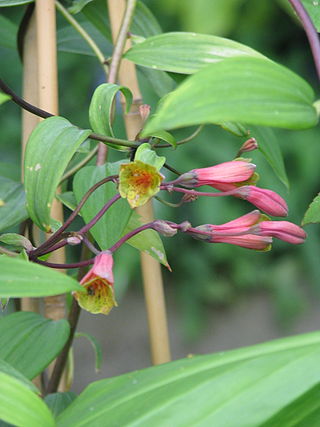
Bomarea edulis, common name salsilla, is a species of flowering plant in the alstroemeria family Alstroemeriaceae, that is native to the tropics of Mexico and the United States. A deciduous climber growing to 2.5 metres (8.2 ft) tall and wide, it has lanceolate leaves and clusters of trumpet-shaped flowers in shades of pink, yellow and green, with variable spotting, that are produced throughout the summer.

Bomarea salsilla is a species of flowering plant in the genus Bomarea, native to Chile. It is distributed between the Valparaíso and Araucanía regions. It has gained the Royal Horticultural Society's Award of Garden Merit.



















